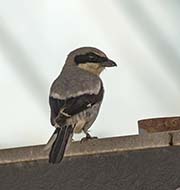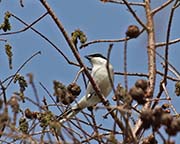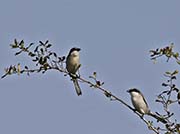Loggerhead Shrike - Lanius ludovicianus
| Length | |
| Wingspan | |
| Weight | |
| Clutch Size | |
| Chicks at birth | |
| IUCN Conservation Status | |
Continents: |
The Loggerhead Shrike is a medium sized passerine with a gray head and back. It's throat and chest are white, its wings are black and white, and its tail is black with white stripes along the sides. It has a black facial mask that extends over the bill and there is usually a dull white supercilium over the mask. The bill is relatively large and is hooked. Males and females look similar.
Diet: The Loggerhead Shrike prey includes mice, reptiles, amphibians, and small birds. It has also been known to eat carrion. It kills its prey by biting the back of the neck. They then impale the prey on barbed wire, cactus spines, twigs, and other sharp objects. They use their hooked bill to tear off pieces of their prey. They can store the impaled food for later eating or feeding to their young.
Courtship: To attract a female, male Loggerhead Shrikes will build up a cache of food. The male performs a dance to attract a female and offers food. If the female accepts the food, they will then mate.
Nesting: Loggerhead Shrikes prefer to nest in bushes with thorns which probably helps to protect the nest from predators. In some areas multiple broods will be hatched. Also, if the brood fails, re-nesting will take place. The female lays 5-7 eggs. The eggs are hatched asynchornously, which means that in lean years, chicks that hatch later will probably die due to lack of food.
Habitat and Range: Loggerhead Shrikes prefer semi-open country with spiny shrubs and low trees. They are frequently seen perched on telephone wires, fence posts, trees, etc. They are found throughout the U.S. and Mexico and parts of Canada. They are very territorial and will use vocalization to scare off other shrikes. Their numbers are declining in Canada and the U.S. and it is unclear why.
Vocalization: Song is a complex and variable sequence of harsh notes, chatter, trills, and whistles.
Plumage/Molt: The adult Loggerhead Shrike undergo a complete molt once a year after the young have fledged.
Migration: Migration is only done by Shrikes that breed in Canada and northern U.S.
Tongue/feet: Many technical papers say that Loggerhead Shrikes have weak feet and that is why they impale their prey and then eat it. Others say that that their feet are not weak and cite that the shrikes can carry a captured bird quite a distance. They believe that their legs are too short and too far back to hold the prey while eating it.
Bibliography:
- http://www.birds.cornell.edu The Cornell Lab of Ornithology, Accessed June, 2012
- http://en.wikipedia.org The Free Encyclopedia, Accessed June, 2012
- http://birding.about.com About.com, Accessed June, 2012
- Lefranc, Norbert, Shrikes, A guide to the Shrikes of the World,Yale University Press, 1997, Accessed June, 2012
- http://bna.birds.cornell.edu/bna The Birds of North America Online from the Cornell Lab of Ornithology, Accessed June, 2012










